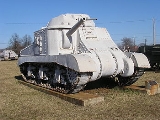
M3 Lee
Encyclopedia
The Medium Tank M3 was an American
tank
used during World War II
. In Britain
the tank was called "General Lee", named after Confederate
General Robert E. Lee
, and the modified version built with a new turret was called the "General Grant", named after U.S. General Ulysses S. Grant
.
Design commenced in July 1940, and the first "Lees" were operational in late 1941. The U.S. Army needed a good tank and coupled with Great Britain
's demand for 3,650 medium tanks immediately, the Lee began production by late 1940. The M3 was well armed and armored for the period, but due to design flaws (high silhouette, archaic sponson
mounting of the main gun, below average off-road performance) it was not satisfactory and was withdrawn from front line
duty as soon as the M4 Sherman
became available in large numbers.
possessed approximately 400 tanks, mostly M2
light tanks, with less than a hundred of the discontinued M2
medium tanks. The U.S. funded tank development poorly during the interwar years, and had no infrastructure for production, little experience in design, and poor doctrine to guide design efforts.
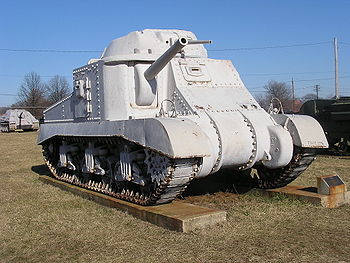 The M2
The M2
series medium tank was typical of AFVs many nations produced in 1939. When the U.S. entered the war, the M2 design was obsolete with a 37 mm gun, 32 mm frontal armor, machine gun main armament and a very high silhouette. The Panzer III
and Panzer IV
's success in the French campaign
led the U.S. Army to immediately order a new medium tank armed with a 75 mm gun
in a turret. This would be the M4 Sherman. However, until the Sherman was in production, an interim design with a 75 mm gun was urgently needed.
The M3 was the solution. The design was unusual because the main weapon — a larger caliber, low-velocity 75 mm gun — was in an offset sponson
mounted in the hull with limited traverse. A small turret with a lighter, high-velocity 37 mm gun sat on the tall hull. A small cupola on top of the turret held a machine gun
. The use of two main guns was seen on the French Char B
, the Soviet
T-35
, and the Mark I version of the British
Churchill tank
. In each case, two weapons were mounted to give the tanks adequate capability in firing both anti-personnel high explosive ammunition and armor-piercing ammunition for anti-tank combat. The M3 differed slightly from this pattern having a main gun which could fire an armor-piercing projectile at a velocity high enough for efficiently piercing armor, as well as deliver a high-explosive shell that was large enough to be effective. Using a hull mounted gun, the M3 design was produced quicker than if a turret mount gun had been manufactured. It was understood that the M3 design was flawed, but Britain
urgently needed tanks.
The M3 was tall and roomy: the power transmission ran through the crew compartment under the turret cage to the gearbox driving the front sprockets. Steering was by differential braking, with a turning circle of 37 ft (11.3 m). The vertical volute suspension units included a return roller made with self-contained and readily replaced units bolted to the chassis. The turret was power-traversed by a electro-hydraulic system — a electric motor providing the pressure for the hydraulic motor. This rotated the turret fully in 15 seconds. Control was from a spade grip on the gun. The same motor provided pressure for the gun stabilizing system.
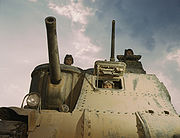 The 75-mm was operated by a gunner and a loader. Sighting the 75-mm gun used a M1 periscope — with an integral telescope — on the top of the sponson. The periscope rotated with the gun. The sight was marked from zero to 3000 yd (2,743.2 m) with vertical markings to aid deflection shooting at a moving target. The gunner laid the gun on target through geared handwheels for traverse and elevation.
The 75-mm was operated by a gunner and a loader. Sighting the 75-mm gun used a M1 periscope — with an integral telescope — on the top of the sponson. The periscope rotated with the gun. The sight was marked from zero to 3000 yd (2,743.2 m) with vertical markings to aid deflection shooting at a moving target. The gunner laid the gun on target through geared handwheels for traverse and elevation.
The 37-mm was aimed through the M2 periscope, though this was mounted in the mantlet to the side of the gun. It also sighted the coaxial machine gun. Two range scales were provided: 0-1500 yd (1,371.6 m) for the 37-mm and 0-1000 yd (914.4 m) for the machine gun.
The British ordered the M3 when they were refused permission to have their tank designs (the Matilda infantry tank
and Crusader cruiser tank
) made by American factories. British experts had viewed the mock-up in 1940 and identified several flaws — the high profile, the hull mounted gun, radio down in the hull (instead of turret), smooth tracks, riveted armour and insufficient armour little attention to splash-proofing the joints. The British agreed to order 1,250 M3, to be modified to their requirements - the order was subsequently increased with the expectation that when a superior tank was available it could replace part of the order. Contracts were arranged with three U.S. companies, but the total cost was approximately 240 million US dollars. This sum was all of the British funds in the US and it took the Lend-Lease act to solve the financial problems.
The prototype was completed in March 1941 and production models followed with the first British specification tanks in July. The British cast turret included a bustle at the back for the Wireless Set No. 19
radio
. It had thicker armour than the U.S. one and removed the U.S. cupola for a simple hatch. Both U.S. and British tanks had thicker armour than first planned. The British design required one fewer crew member than the US version due to the radio in the turret. The U.S. eventually eliminated the full-time radio operator, assigning the task to the driver. The British realized that to meet their requirement for tanks both types would be needed.
The U.S. military utilized the "M" (Model) letter to designate nearly all of their equipment. When the British Army received their new M3 medium tanks from the US, confusion immediately set in, as the M3 medium tank and the M3 light tank were identically named. The British army began naming their American tanks, although the U.S. Army never used those terms until after the war. The M3 tanks with the new turret and radio setup received the name "General Grant", while the original M3s were called "General Lee", or more usually just "Grant" and "Lee". The M3 brought much-needed firepower to British forces in the African desert campaign
.
The chassis and running gear of the M3 design was adapted by the Canadians for their Ram tank
. The hull of the M3 was also used for self-propelled artillery
and recovery vehicles.
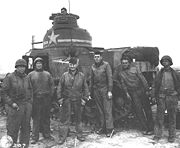
. Consequently, one of the American M3 medium tank's first actions during the war was in 1942, during the North African Campaign
. British Lees and Grants were in action against Rommel's
forces at the disastrous Battle of Gazala
on 27 May that year. They continued to serve in North Africa until the end of that campaign. A regiment of M3 Mediums was also used by the U.S. 1st Armored Division
in North Africa. In the North African campaign, the M3 was generally appreciated for its mechanical reliability, good armor and heavy firepower.
In all three areas, it outclassed the available British tanks and was able to fight German tanks
and towed anti-tank guns. The tall silhouette and low, hull-mounted 75-mm were severe tactical drawbacks. since they prevented the tank from fighting from hull-down
firing positions. The use of riveted armor led to a problem called "spalling," whereby the impact of enemy shells would cause the rivets to break off and become projectiles inside the tank. Later models were welded to eliminate this problem. The M3 was replaced by the M4 Sherman
as soon as these were available, though several M3s saw limited action in the battle for Normandy as armored recovery vehicles with dummy guns.
Over 1,300 diesel-engined M3A3 and M3A5s were supplied to the USSR via lend-lease
in 1942-1943. All were the Lee variants, although they are sometimes referred to generically as Grants. The M3 was unpopular in the Red Army
, where its faults showed up in engagements with enemy armor and anti-tank weapons, with the Soviets bestowing it the nickname of "coffin for seven brothers." Few were seen in combat after about mid-1943, though some M3s were used on the Arctic Front in the Red Army's offensive on the Litsa front
towards Kirkenes
in October 1944. The Germans had on this front only relatively few obsolete French Hotchkiss
and Somua tanks that they had acquired during occupation, consequently the M3's inferior tank-to-tank capabilities were of limited importance.
was an ocean war fought primarily by the naval fleets of the U.S. and the Empire of Japan
. Tank warfare would play a secondary role, the primary battles being between warships. Within the Pacific Theater of Operations
(PTO), the U.S. Marine Corps
deployed all six of its tank battalions; the U.S. Army deployed only a third of its 70 separate tank battalions, and none of its armored divisions, in the Pacific.
During the battle for Tarawa island in 1943, the U.S. Army attacked nearby Makin Island
, which was considered a less costly operation. The army was supported by a platoon of M3A5 Lee medium tanks from the U.S. Army's 193rd Tank Battalion, making this battle the only U.S. Army combat use of the M3 in the Pacific Theater. No M3s were supplied to the U.S. Marine Corps.
When the British received their new M4 Shermans from America, it quickly transferred approximately 1,700 M3s to the China-Burma-India (CBI) theater
, deploying about 800 M3s to Australian forces and about 900 M3 tanks to Indian forces. British Lees and Grants were used by the British Fourteenth Army from the fall of Rangoon, performing admirably until the end of the war. In the Far East
, the M3's main task was infantry
support. It played a pivotal role during the Battle of Imphal
, during which the Imperial Japanese Army
's 14th Tank Regiment (consisting of mostly captured British M3 Stuart light tanks and their own Type 95
light tanks) encountered M3 medium tanks for the first time. Despite their lower-than-average off-road performance, the M3s performed well as they traversed the steep hillsides around Imphal
.
Declared obsolete in April 1944, the General Lee fought on against Japan until the end of the war. In the end, the M3 in the CBI theater performed the mission its original designers had intended it to do: that of supporting the infantry.
, the up-gunning of the Panzer IV
to a long 75-mm gun
, and further in 1943 the appearance of the Panthers
, along with the availability of large numbers of Shermans, the M3 was withdrawn from service in the European Theater.
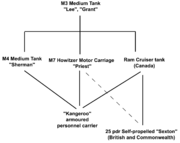
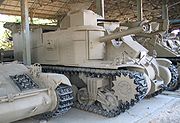
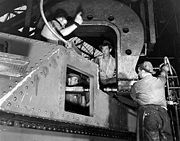 British designations in parentheses
British designations in parentheses
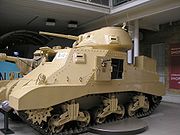
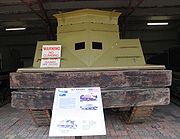
, the character's main form of transportation was an M3 Grant named "Lulu Belle".
In the 1979 Steven Spielberg
movie 1941, starring Dan Aykroyd
and John Belushi
, an M3 Lee is a featured element. It is not, however, a real M3. Instead, it was a plywood body on an agricultural tractor chassis.
United States
The United States of America is a federal constitutional republic comprising fifty states and a federal district...
tank
Tank
A tank is a tracked, armoured fighting vehicle designed for front-line combat which combines operational mobility, tactical offensive, and defensive capabilities...
used during World War II
World War II
World War II, or the Second World War , was a global conflict lasting from 1939 to 1945, involving most of the world's nations—including all of the great powers—eventually forming two opposing military alliances: the Allies and the Axis...
. In Britain
United Kingdom
The United Kingdom of Great Britain and Northern IrelandIn the United Kingdom and Dependencies, other languages have been officially recognised as legitimate autochthonous languages under the European Charter for Regional or Minority Languages...
the tank was called "General Lee", named after Confederate
Confederate States Army
The Confederate States Army was the army of the Confederate States of America while the Confederacy existed during the American Civil War. On February 8, 1861, delegates from the seven Deep South states which had already declared their secession from the United States of America adopted the...
General Robert E. Lee
Robert E. Lee
Robert Edward Lee was a career military officer who is best known for having commanded the Confederate Army of Northern Virginia in the American Civil War....
, and the modified version built with a new turret was called the "General Grant", named after U.S. General Ulysses S. Grant
Ulysses S. Grant
Ulysses S. Grant was the 18th President of the United States as well as military commander during the Civil War and post-war Reconstruction periods. Under Grant's command, the Union Army defeated the Confederate military and ended the Confederate States of America...
.
Design commenced in July 1940, and the first "Lees" were operational in late 1941. The U.S. Army needed a good tank and coupled with Great Britain
Great Britain
Great Britain or Britain is an island situated to the northwest of Continental Europe. It is the ninth largest island in the world, and the largest European island, as well as the largest of the British Isles...
's demand for 3,650 medium tanks immediately, the Lee began production by late 1940. The M3 was well armed and armored for the period, but due to design flaws (high silhouette, archaic sponson
Sponson
Sponsons are projections from the sides of a watercraft, for protection, stability, or the mounting of equipment such as armaments or lifeboats, etc...
mounting of the main gun, below average off-road performance) it was not satisfactory and was withdrawn from front line
Front line
A front line is the farthest-most forward position of an armed force's personnel and equipment - generally in respect of maritime or land forces. Forward Line of Own Troops , or Forward Edge of Battle Area are technical terms used by all branches of the armed services...
duty as soon as the M4 Sherman
M4 Sherman
The M4 Sherman, formally Medium Tank, M4, was the primary tank used by the United States during World War II. Thousands were also distributed to the Allies, including the British Commonwealth and Soviet armies, via lend-lease...
became available in large numbers.
History
In 1939, the U.S. ArmyUnited States Army
The United States Army is the main branch of the United States Armed Forces responsible for land-based military operations. It is the largest and oldest established branch of the U.S. military, and is one of seven U.S. uniformed services...
possessed approximately 400 tanks, mostly M2
M2 Light Tank
The Light Tank M2 was an American pre-World War II light tank that saw combat with the US Marine Corps 1st Tank Battalion on Guadalcanal in 1942, during World War II. Its service with the 1st Tank Battalion during the Pacific War was its only U.S...
light tanks, with less than a hundred of the discontinued M2
M2 Medium Tank
The Medium Tank M2 was a United States Army tank that was first produced in 1939 by the Rock Island Arsenal, just prior to the commencement of the war in Europe. Production was 18 M2 tanks, and 94 slightly improved M2A1 tanks, for a total figure of 112...
medium tanks. The U.S. funded tank development poorly during the interwar years, and had no infrastructure for production, little experience in design, and poor doctrine to guide design efforts.

M2 Medium Tank
The Medium Tank M2 was a United States Army tank that was first produced in 1939 by the Rock Island Arsenal, just prior to the commencement of the war in Europe. Production was 18 M2 tanks, and 94 slightly improved M2A1 tanks, for a total figure of 112...
series medium tank was typical of AFVs many nations produced in 1939. When the U.S. entered the war, the M2 design was obsolete with a 37 mm gun, 32 mm frontal armor, machine gun main armament and a very high silhouette. The Panzer III
Panzer III
Panzer III was the common name of a medium tank that was developed in the 1930s by Germany and was used extensively in World War II. The official German designation was Panzerkampfwagen III translating as "armoured battle vehicle". It was intended to fight other armoured fighting vehicles and...
and Panzer IV
Panzer IV
The Panzerkampfwagen IV , commonly known as the Panzer IV, was a medium tank developed in Nazi Germany in the late 1930s and used extensively during the Second World War. Its ordnance inventory designation was Sd.Kfz...
's success in the French campaign
Battle of France
In the Second World War, the Battle of France was the German invasion of France and the Low Countries, beginning on 10 May 1940, which ended the Phoney War. The battle consisted of two main operations. In the first, Fall Gelb , German armoured units pushed through the Ardennes, to cut off and...
led the U.S. Army to immediately order a new medium tank armed with a 75 mm gun
75 mm Gun (US)
The US 75 mm gun tank gun M2 and the later M3 were the standard American tank guns of the Second World War.Besides use on the two main American medium tanks of the war the M3 Lee and the M4 Sherman . The lightweight M6 and M5 variants were developed to equip the Light Tank M24 and the B-25...
in a turret. This would be the M4 Sherman. However, until the Sherman was in production, an interim design with a 75 mm gun was urgently needed.
The M3 was the solution. The design was unusual because the main weapon — a larger caliber, low-velocity 75 mm gun — was in an offset sponson
Sponson
Sponsons are projections from the sides of a watercraft, for protection, stability, or the mounting of equipment such as armaments or lifeboats, etc...
mounted in the hull with limited traverse. A small turret with a lighter, high-velocity 37 mm gun sat on the tall hull. A small cupola on top of the turret held a machine gun
Machine gun
A machine gun is a fully automatic mounted or portable firearm, usually designed to fire rounds in quick succession from an ammunition belt or large-capacity magazine, typically at a rate of several hundred rounds per minute....
. The use of two main guns was seen on the French Char B
Char B1
The Char B1 was a French heavy tank manufactured before World War II.The Char B1 was a specialised heavy break-through vehicle, originally conceived as a self-propelled gun with a 75 mm howitzer in the hull; later a 47 mm gun in a turret was added, to allow it to function also as a Char...
, the Soviet
Soviet Union
The Soviet Union , officially the Union of Soviet Socialist Republics , was a constitutionally socialist state that existed in Eurasia between 1922 and 1991....
T-35
T-35
The T-35 was a Soviet multi-turreted heavy tank of the interwar period and early Second World War that saw limited production and service with the Red Army. It was the only five-turreted heavy tank in the world to reach production but proved to be slow and mechanically unreliable...
, and the Mark I version of the British
United Kingdom
The United Kingdom of Great Britain and Northern IrelandIn the United Kingdom and Dependencies, other languages have been officially recognised as legitimate autochthonous languages under the European Charter for Regional or Minority Languages...
Churchill tank
Churchill tank
The Tank, Infantry, Mk IV was a heavy British infantry tank used in the Second World War, best known for its heavy armour, large longitudinal chassis with all-around tracks with multiple bogies, and its use as the basis of many specialist vehicles. It was one of the heaviest Allied tanks of the war...
. In each case, two weapons were mounted to give the tanks adequate capability in firing both anti-personnel high explosive ammunition and armor-piercing ammunition for anti-tank combat. The M3 differed slightly from this pattern having a main gun which could fire an armor-piercing projectile at a velocity high enough for efficiently piercing armor, as well as deliver a high-explosive shell that was large enough to be effective. Using a hull mounted gun, the M3 design was produced quicker than if a turret mount gun had been manufactured. It was understood that the M3 design was flawed, but Britain
United Kingdom
The United Kingdom of Great Britain and Northern IrelandIn the United Kingdom and Dependencies, other languages have been officially recognised as legitimate autochthonous languages under the European Charter for Regional or Minority Languages...
urgently needed tanks.
The M3 was tall and roomy: the power transmission ran through the crew compartment under the turret cage to the gearbox driving the front sprockets. Steering was by differential braking, with a turning circle of 37 ft (11.3 m). The vertical volute suspension units included a return roller made with self-contained and readily replaced units bolted to the chassis. The turret was power-traversed by a electro-hydraulic system — a electric motor providing the pressure for the hydraulic motor. This rotated the turret fully in 15 seconds. Control was from a spade grip on the gun. The same motor provided pressure for the gun stabilizing system.

The 37-mm was aimed through the M2 periscope, though this was mounted in the mantlet to the side of the gun. It also sighted the coaxial machine gun. Two range scales were provided: 0-1500 yd (1,371.6 m) for the 37-mm and 0-1000 yd (914.4 m) for the machine gun.
The British ordered the M3 when they were refused permission to have their tank designs (the Matilda infantry tank
Matilda tank
The Infantry Tank Mark II known as the Matilda II was a British infantry tank of the Second World War. It was also identified from its General Staff Specification A12....
and Crusader cruiser tank
Crusader tank
The Tank, Cruiser, Mk VI or A15 Crusader was one of the primary British cruiser tanks of the early part Second World War and perhaps the most important British tank of the North African Campaign...
) made by American factories. British experts had viewed the mock-up in 1940 and identified several flaws — the high profile, the hull mounted gun, radio down in the hull (instead of turret), smooth tracks, riveted armour and insufficient armour little attention to splash-proofing the joints. The British agreed to order 1,250 M3, to be modified to their requirements - the order was subsequently increased with the expectation that when a superior tank was available it could replace part of the order. Contracts were arranged with three U.S. companies, but the total cost was approximately 240 million US dollars. This sum was all of the British funds in the US and it took the Lend-Lease act to solve the financial problems.
The prototype was completed in March 1941 and production models followed with the first British specification tanks in July. The British cast turret included a bustle at the back for the Wireless Set No. 19
Wireless Set No. 19
The Wireless Set No. 19 was a Second World War mobile radio transceiver designed for the British Army to give armoured troops reliable communications.- Specifications :...
radio
Combat-net radio
In telecommunication, a combat-net radio is a radio operating in a network that provides a half-duplex circuit and uses either a single radio frequency or a discrete set of radio frequencies when in a frequency hopping mode....
. It had thicker armour than the U.S. one and removed the U.S. cupola for a simple hatch. Both U.S. and British tanks had thicker armour than first planned. The British design required one fewer crew member than the US version due to the radio in the turret. The U.S. eventually eliminated the full-time radio operator, assigning the task to the driver. The British realized that to meet their requirement for tanks both types would be needed.
The U.S. military utilized the "M" (Model) letter to designate nearly all of their equipment. When the British Army received their new M3 medium tanks from the US, confusion immediately set in, as the M3 medium tank and the M3 light tank were identically named. The British army began naming their American tanks, although the U.S. Army never used those terms until after the war. The M3 tanks with the new turret and radio setup received the name "General Grant", while the original M3s were called "General Lee", or more usually just "Grant" and "Lee". The M3 brought much-needed firepower to British forces in the African desert campaign
North African campaign
During the Second World War, the North African Campaign took place in North Africa from 10 June 1940 to 13 May 1943. It included campaigns fought in the Libyan and Egyptian deserts and in Morocco and Algeria and Tunisia .The campaign was fought between the Allies and Axis powers, many of whom had...
.
The chassis and running gear of the M3 design was adapted by the Canadians for their Ram tank
Ram tank
The Tank Cruiser, Ram was a cruiser tank designed and built by Canada in the Second World War, based on the U.S. M3 Medium tank. Due to the entrance of the United States into the war and the superior design of the American Sherman, it was used exclusively for training purposes and was never used in...
. The hull of the M3 was also used for self-propelled artillery
Artillery
Originally applied to any group of infantry primarily armed with projectile weapons, artillery has over time become limited in meaning to refer only to those engines of war that operate by projection of munitions far beyond the range of effect of personal weapons...
and recovery vehicles.
Combat performance

European and Mediterranean Theaters
Of the 6,258 M3s produced by the U.S., 2,855 M3s were supplied to the British army, and about 1,386 to the Soviet UnionSoviet Union
The Soviet Union , officially the Union of Soviet Socialist Republics , was a constitutionally socialist state that existed in Eurasia between 1922 and 1991....
. Consequently, one of the American M3 medium tank's first actions during the war was in 1942, during the North African Campaign
North African campaign
During the Second World War, the North African Campaign took place in North Africa from 10 June 1940 to 13 May 1943. It included campaigns fought in the Libyan and Egyptian deserts and in Morocco and Algeria and Tunisia .The campaign was fought between the Allies and Axis powers, many of whom had...
. British Lees and Grants were in action against Rommel's
Erwin Rommel
Erwin Johannes Eugen Rommel , popularly known as the Desert Fox , was a German Field Marshal of World War II. He won the respect of both his own troops and the enemies he fought....
forces at the disastrous Battle of Gazala
Battle of Gazala
The Battle of Gazala was an important battle of the Second World War Western Desert Campaign, fought around the port of Tobruk in Libya from 26 May-21 June 1942...
on 27 May that year. They continued to serve in North Africa until the end of that campaign. A regiment of M3 Mediums was also used by the U.S. 1st Armored Division
1st Armored Division (United States)
The 1st Armored Division—nicknamed "Old Ironsides"—is a standing armored division of the United States Army with base of operations in Fort Bliss, Texas. It was the first armored division of the U.S...
in North Africa. In the North African campaign, the M3 was generally appreciated for its mechanical reliability, good armor and heavy firepower.
In all three areas, it outclassed the available British tanks and was able to fight German tanks
Panzer
A Panzer is a German language word that, when used as a noun, means "tank". When it is used as an adjective, it means either tank or "armoured" .- Etymology :...
and towed anti-tank guns. The tall silhouette and low, hull-mounted 75-mm were severe tactical drawbacks. since they prevented the tank from fighting from hull-down
Hull-down
The term hull-down describes the situation where the upper part of a vessel or vehicle is visible, but the main, lower body is not; the opposite term hull-up describes the situation where all of the body is visible....
firing positions. The use of riveted armor led to a problem called "spalling," whereby the impact of enemy shells would cause the rivets to break off and become projectiles inside the tank. Later models were welded to eliminate this problem. The M3 was replaced by the M4 Sherman
M4 Sherman
The M4 Sherman, formally Medium Tank, M4, was the primary tank used by the United States during World War II. Thousands were also distributed to the Allies, including the British Commonwealth and Soviet armies, via lend-lease...
as soon as these were available, though several M3s saw limited action in the battle for Normandy as armored recovery vehicles with dummy guns.
Over 1,300 diesel-engined M3A3 and M3A5s were supplied to the USSR via lend-lease
Lend-Lease
Lend-Lease was the program under which the United States of America supplied the United Kingdom, the Soviet Union, China, Free France, and other Allied nations with materiel between 1941 and 1945. It was signed into law on March 11, 1941, a year and a half after the outbreak of war in Europe in...
in 1942-1943. All were the Lee variants, although they are sometimes referred to generically as Grants. The M3 was unpopular in the Red Army
Red Army
The Workers' and Peasants' Red Army started out as the Soviet Union's revolutionary communist combat groups during the Russian Civil War of 1918-1922. It grew into the national army of the Soviet Union. By the 1930s the Red Army was among the largest armies in history.The "Red Army" name refers to...
, where its faults showed up in engagements with enemy armor and anti-tank weapons, with the Soviets bestowing it the nickname of "coffin for seven brothers." Few were seen in combat after about mid-1943, though some M3s were used on the Arctic Front in the Red Army's offensive on the Litsa front
Petsamo-Kirkenes Operation
The Petsamo–Kirkenes Offensive was a major military offensive during World War II, mounted by the Red Army against the Wehrmacht in 1944 in northern Finland and Norway. The offensive defeated the Wehrmachts forces in the Arctic, driving them back into Norway, and was called the "Tenth Shock" by...
towards Kirkenes
Kirkenes
is a town in the municipality of Sør-Varanger in the county of Finnmark in the far northeast of Norway...
in October 1944. The Germans had on this front only relatively few obsolete French Hotchkiss
Hotchkiss H35
The Hotchkiss H35 or Char léger modèle 1935 H was a French light tank developed prior to World War II.Despite having been designed from 1933 as a rather slow but well-armoured light infantry support tank, the type was initially rejected by the French Infantry because it proved difficult to steer...
and Somua tanks that they had acquired during occupation, consequently the M3's inferior tank-to-tank capabilities were of limited importance.
Pacific and China-Burma-India Theaters
The Pacific WarPacific War
The Pacific War, also sometimes called the Asia-Pacific War refers broadly to the parts of World War II that took place in the Pacific Ocean, its islands, and in East Asia, then called the Far East...
was an ocean war fought primarily by the naval fleets of the U.S. and the Empire of Japan
Empire of Japan
The Empire of Japan is the name of the state of Japan that existed from the Meiji Restoration on 3 January 1868 to the enactment of the post-World War II Constitution of...
. Tank warfare would play a secondary role, the primary battles being between warships. Within the Pacific Theater of Operations
Pacific Theater of Operations
The Pacific Theater of Operations was the World War II area of military activity in the Pacific Ocean and the countries bordering it, a geographic scope that reflected the operational and administrative command structures of the American forces during that period...
(PTO), the U.S. Marine Corps
United States Marine Corps
The United States Marine Corps is a branch of the United States Armed Forces responsible for providing power projection from the sea, using the mobility of the United States Navy to deliver combined-arms task forces rapidly. It is one of seven uniformed services of the United States...
deployed all six of its tank battalions; the U.S. Army deployed only a third of its 70 separate tank battalions, and none of its armored divisions, in the Pacific.
During the battle for Tarawa island in 1943, the U.S. Army attacked nearby Makin Island
Makin Island
Makin Island may refer to:* Butaritari, an atoll in Kiribati* Makin * USS Makin Island...
, which was considered a less costly operation. The army was supported by a platoon of M3A5 Lee medium tanks from the U.S. Army's 193rd Tank Battalion, making this battle the only U.S. Army combat use of the M3 in the Pacific Theater. No M3s were supplied to the U.S. Marine Corps.
When the British received their new M4 Shermans from America, it quickly transferred approximately 1,700 M3s to the China-Burma-India (CBI) theater
China Burma India Theater of World War II
China Burma India Theater was the name used by the United States Army for its forces operating in conjunction with British and Chinese Allied air and land forces in China, Burma, and India during World War II...
, deploying about 800 M3s to Australian forces and about 900 M3 tanks to Indian forces. British Lees and Grants were used by the British Fourteenth Army from the fall of Rangoon, performing admirably until the end of the war. In the Far East
Far East
The Far East is an English term mostly describing East Asia and Southeast Asia, with South Asia sometimes also included for economic and cultural reasons.The term came into use in European geopolitical discourse in the 19th century,...
, the M3's main task was infantry
Infantry
Infantrymen are soldiers who are specifically trained for the role of fighting on foot to engage the enemy face to face and have historically borne the brunt of the casualties of combat in wars. As the oldest branch of combat arms, they are the backbone of armies...
support. It played a pivotal role during the Battle of Imphal
Battle of Imphal
The Battle of Imphal took place in the region around the city of Imphal, the capital of the state of Manipur in North-East India from March until July 1944. Japanese armies attempted to destroy the Allied forces at Imphal and invade India, but were driven back into Burma with heavy losses...
, during which the Imperial Japanese Army
Imperial Japanese Army
-Foundation:During the Meiji Restoration, the military forces loyal to the Emperor were samurai drawn primarily from the loyalist feudal domains of Satsuma and Chōshū...
's 14th Tank Regiment (consisting of mostly captured British M3 Stuart light tanks and their own Type 95
Type 95
Type 95 can refer to:* Type 95 Ha-Go, a Japanese light tank* Type 95 recon car* Type 95 SPAAA, a Chinese anti-aircraft vehicle* Type 95 torpedo* QBZ-95, Chinese assault rifle* QBB-95, Chinese light support weapon...
light tanks) encountered M3 medium tanks for the first time. Despite their lower-than-average off-road performance, the M3s performed well as they traversed the steep hillsides around Imphal
Imphal
Imphal is the capital of the Indian state of Manipur.In the heart of the town and surrounded by a moat, are ruins of the old Palace of Kangla. Kangla Fort used to be the home of the Assam Rifles, a paramilitary force and on November 2004 it was handed over to state of Manipur by Prime minister Dr....
.
Declared obsolete in April 1944, the General Lee fought on against Japan until the end of the war. In the end, the M3 in the CBI theater performed the mission its original designers had intended it to do: that of supporting the infantry.
Overview
Overall, the M3 was able to cope with the battlefield of 1942. Its armor and firepower were the equal or superior to most of the threats it faced. Long-range, high velocity guns were not yet common on German tanks in theatre. However, the rapid pace of tank development, and amongst other things its riveted armour meant that the M3 was very quickly outclassed. By mid-1942, with the introduction of the German TigersTiger I
Tiger I is the common name of a German heavy tank developed in 1942 and used in World War II. The final official German designation was Panzerkampfwagen Tiger Ausf. E, often shortened to Tiger. It was an answer to the unexpectedly formidable Soviet armour encountered in the initial months of...
, the up-gunning of the Panzer IV
Panzer IV
The Panzerkampfwagen IV , commonly known as the Panzer IV, was a medium tank developed in Nazi Germany in the late 1930s and used extensively during the Second World War. Its ordnance inventory designation was Sd.Kfz...
to a long 75-mm gun
7.5 cm KwK 40
The 7.5 cm KwK 40 was a German 7.5 cm Second World War era vehicle mounted gun, used as the primary anti-tank weapon of the German medium tank the SdKfz.161 Panzerkampfwagen IV and the SdKfz.142 Sturmgeschütz III assault guns ...
, and further in 1943 the appearance of the Panthers
Panther tank
Panther is the common name of a medium tank fielded by Nazi Germany in World War II that served from mid-1943 to the end of the European war in 1945. It was intended as a counter to the T-34, and to replace the Panzer III and Panzer IV; while never replacing the latter, it served alongside it as...
, along with the availability of large numbers of Shermans, the M3 was withdrawn from service in the European Theater.
Variants



US variants
- M3 (Lee I/Grant I).
- Riveted hull, high profile turret, gasoline engine. 4,724 built.
- M3A1 (Lee II).
- Cast (rounded) upper hull. 300 built.
- M3A2 (Lee III).
- Welded (sharp edged) hull. Only 12 vehicles produced.
- M3A3 (Lee IV/Lee V).
- Twin GM 6-71Detroit Diesel Series 71The Detroit Diesel Series 71 is a two-stroke cycle diesel engine series, available in both inline and V configurations, with the inline models including one, two, three, four and six cylinders, and the V-types including six, eight, 12, 16 and 24 cylinders...
dieselDiesel engineA diesel engine is an internal combustion engine that uses the heat of compression to initiate ignition to burn the fuel, which is injected into the combustion chamber...
variant of welded hull. Side doors welded shut or eliminated. 322 built.
- Twin GM 6-71
- M3A4 (Lee VI).
- Stretched riveted hull, 1 x ChryslerChryslerChrysler Group LLC is a multinational automaker headquartered in Auburn Hills, Michigan, USA. Chrysler was first organized as the Chrysler Corporation in 1925....
A-57 Multibank engine, made up of 5 4.12 litre 6-cyl L-head car engines (block upwards) mated to a common crankshaft, displacement 21 litres, 470 hp @ 2700rpm. Side doors eliminated. 109 built.
- Stretched riveted hull, 1 x Chrysler
- M3A5 (Grant II) .
- Twin GM 6-71 diesel variant of riveted hull M3. Despite having the original Lee turret and not the Grant one, was referred by the British as Grant II. 591 built.
- M31 Tank Recovery Vehicle (Grant ARV I).
- Based on M3 chassisChassisA chassis consists of an internal framework that supports a man-made object. It is analogous to an animal's skeleton. An example of a chassis is the underpart of a motor vehicle, consisting of the frame with the wheels and machinery.- Vehicles :In the case of vehicles, the term chassis means the...
, with dummy turret and dummy 75 gun. 60000 lb (27,215.5 kg) winch installed.
- Based on M3 chassis
- M31B1 Tank Recovery Vehicle.
- Based on M3A3.
- M31B2 Tank Recovery Vehicle.
- Based on M3A5.
- M33 Prime Mover.
- M31 TRV converted to the artillery tractor role, with turret and crane removed. 109 vehicles were converted in 1943-44.
- 105 mm Howitzer Motor Carriage M7M7 PriestThe 105 mm Howitzer Motor Carriage M7 was an American self-propelled artillery vehicle produced during World War II. It was given the official service name 105 mm Self Propelled Gun, Priest by the British Army, due to the pulpit-like machine gun ring, and following on from the Bishop and...
(Priest)- 105 mm M1/M2 howitzerHowitzerA howitzer is a type of artillery piece characterized by a relatively short barrel and the use of comparatively small propellant charges to propel projectiles at relatively high trajectories, with a steep angle of descent...
installed in open superstructureSuperstructureA superstructure is an upward extension of an existing structure above a baseline. This term is applied to various kinds of physical structures such as buildings, bridges, or ships...
. - Gunless version was the OP (observation post vehicle)
- 105 mm M1/M2 howitzer
- 155 mm Gun Motor Carriage M12M12 Gun Motor CarriageThe 155 mm Gun Motor Carriage M12 was a U.S. self-propelled gun developed during the Second World War. Only 100 were built; 60 in 1942 and a further 40 in 1943. It mounted a 155 mm gun M1917, M1917A1 or M1918 M1, depending upon availability, a weapon derived from the nearly identical...
- Designed as the T-6. A 155 mm howitzer on M3 chassis.
British variants

- Grant ARV
- Grant I's and Grant II's with guns removed and replaced with armored recovery vehicle equipment.
- Grant Command
- Grant fitted with map table and extra radio equipment and having guns removed or replaced with dummies.
- Grant Scorpion III
- Grant with 75 mm gun removed, and fitted with Scorpion III mine flailMine flailA mine flail is a vehicle-mounted device that makes a safe path through a mine-field by deliberately detonating land mines in front of the vehicle that carries it. They were first used by the British during World War II....
, few made in early 1943 for use in North Africa.
- Grant with 75 mm gun removed, and fitted with Scorpion III mine flail
- Grant Scorpion IV
- Grant Scorpion III with additional motor to increase Scorpion flail power.
- Grant CDL
- From "Canal Defence LightCanal Defence LightCanal Defence Light was a British "secret weapon" of the Second World War.It was based upon the use of a powerful carbon-arc searchlight mounted on a tank. It was intended to be used during night-time attacks, when the light would allow enemy positions to be targeted...
"; Grants with the 37 mm gun turret replaced by a new turret containing a powerful searchlight and a machine gun. 355 Produced by the Americans as well, it was designated Shop Tractor T10.
- From "Canal Defence Light

Australian Variants
- M3 BARVBARVThe Beach Armoured Recovery Vehicle is a British military support vehicle used for amphibious landings.There have been three different BARVs in British service since their introduction during World War II...
- A single M3A5 Grant tank was converted into a "Beach Armoured Recovery Vehicle".
- YerambaYeramba (artillery)The Yeramba was an Australian self-propelled howitzer built after the end of the Second World War in the late-1940s. They were produced by mounting the 25 pounder gun howitzer on an American M3A5 Grant tank hull, and were converted by the Ordnance Factory in Bendigo from 1950 to 1952...
Self Propelled Gun.- Australian SP 25 pounder. 13 vehicles built in 1949 on M3A5 chassis in a conversion very similar to the Canadian Sexton.
Designs based on chassis
- Medium Tank M4M4 ShermanThe M4 Sherman, formally Medium Tank, M4, was the primary tank used by the United States during World War II. Thousands were also distributed to the Allies, including the British Commonwealth and Soviet armies, via lend-lease...
Sherman - Tank Cruiser, RamRam tankThe Tank Cruiser, Ram was a cruiser tank designed and built by Canada in the Second World War, based on the U.S. M3 Medium tank. Due to the entrance of the United States into the war and the superior design of the American Sherman, it was used exclusively for training purposes and was never used in...
- see article for full list of variants - 105 mm Self Propelled Gun, PriestM7 PriestThe 105 mm Howitzer Motor Carriage M7 was an American self-propelled artillery vehicle produced during World War II. It was given the official service name 105 mm Self Propelled Gun, Priest by the British Army, due to the pulpit-like machine gun ring, and following on from the Bishop and...
- Kangaroo armoured personnel carrierKangaroo (armoured personnel carrier)A Kangaroo was a World War II Commonwealth or British armoured personnel carrier , created by conversion of a tank chassis. Created as an expedient measure by the Canadian Army, the Kangaroos were so successful that they were soon being used by British forces as well...
- 25pdr SP, tracked, Sexton Mark ISexton (artillery)The 25pdr SP, tracked, Sexton was a self-propelled artillery vehicle of World War II, based on an American tank hull design, built by Canada for the British Army, and associated Commonwealth forces, and some of the other Allies....
- Sexton Mark II was on a Sherman type chassis - Ram Observation Post and Ram Gun Position Officer
Film appearances
In the 1943 movie Sahara, starring Humphrey BogartHumphrey Bogart
Humphrey DeForest Bogart was an American actor. He is widely regarded as a cultural icon.The American Film Institute ranked Bogart as the greatest male star in the history of American cinema....
, the character's main form of transportation was an M3 Grant named "Lulu Belle".
In the 1979 Steven Spielberg
Steven Spielberg
Steven Allan Spielberg KBE is an American film director, screenwriter, producer, video game designer, and studio entrepreneur. In a career of more than four decades, Spielberg's films have covered many themes and genres. Spielberg's early science-fiction and adventure films were seen as an...
movie 1941, starring Dan Aykroyd
Dan Aykroyd
Daniel Edward "Dan" Aykroyd, CM is a Canadian comedian, actor, screenwriter, musician, winemaker and ufologist. He was an original cast member of Saturday Night Live, an originator of The Blues Brothers and Ghostbusters and has had a long career as a film actor and screenwriter.-Early...
and John Belushi
John Belushi
John Adam Belushi was an American comedian, actor, and musician, best known as one of the original cast members of the NBC sketch comedy show Saturday Night Live, The Star of the Films National Lampoon's Animal House and the The Blues Brothers and for fronting the American blues and soul...
, an M3 Lee is a featured element. It is not, however, a real M3. Instead, it was a plywood body on an agricultural tractor chassis.
External links
- "U.S. Army's 29 ton tanks packs a 75mm gun" Popular Mechanics, July 1941 - one of the first public articles about the M-3
- "Tanks are Mighty Fine Things", 1946 - 145-page book about wartime production of tanks by Chrysler Corporation, including the M3.
- Lee in 'AFRIKA'
- AFV Database (Pictures)
- World War II Vehicles
- OnWar M3, M3A1, M3A3, M3A4
- M3 in the USSR

